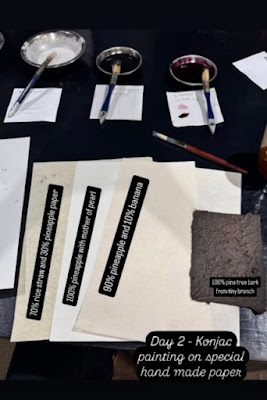I recently had the incredible opportunity to join the workshop led by Asao Shimura, titled
Terakoya kami Kambolan Magatama, held in the remote Sito Poking in Benguet. My friend Windy introduced me to this workshop, and I was particularly drawn to it because I wanted to learn about ampasit culture.
As someone
currently studying shamanism, I find that anything related to animism captivates my interest, and I want to deepen my understanding of Philippine shamanism.
Asao is a Japanese paper master, who married an Ibaloi woman who he met while working in Baguio 30 years ago and chose to settle in herhometown in Benguet. He has dedicated himself to the intricate art of handmade papermaking. Before the workshop, he gave me an ampasit name
Naron which is a variation of my name Rosan. In Ibaloi culture, having an ampasit name holds significant importannce ofr for spiritual identity, offering protection and fostering a sense of community connection.
The workshop spanned four days and began with a traditional rice wine (tapuy) ceremony. The tapuy was made by his sister-in-law Lilia a month prior.
After partaking in the tapuy, Asao jumped right into
teaching us how to make paper from pine tree bark. In the Philippines, cutting down pine trees is strictly regulated to protect the environment and preserve natural resources, so the bark we used came from a tree that has fallen during a typhoon. Asao is committed to sustainability and ensures that nothing goes to waste. That’s why we not only used the bark but also the branches for papermaking.
The paper-making process was meticulous. We started by pounding the pre-cooked pulp, which had been treated in an alkaline solution called Aku. After that, we soaked it in water mixed with mucilage (polyethylene oxide) before using a large deckle (46 x 61 cm) to shape the paper. Asao then pressed the sheets with his unique contraption to squeeze excess water off, and hung the sheets to dry.
In the afternoon, his apprentice, Francine Lima, taught us how to create paper using use indigo pulp without cooking or applying mucilage.
Day 2 focused on exploring Konjac starting with a healthy breakfast prepared by Asao. Konjac is a root vegetable rich in glucomannan, a soluble dietary fiber beneficial for digestion, weight management, and cholesterol reduction. He even made Konjac ice cream for us!
We began the morning by making konjac ink using a variety of natural materials: omija, cinnabar, pine bark, Indian indigo, pearl powder, pine soot, lac, and cochineal. These ingredients are sourced from plants, minerals, and even insects. Asao’s attention to detail was impressive, reflecting his background as an industrial chemist; every ingredient was measured precisely to 0.5 grams and whisked to achieve the right thickness. We created eight different ink colors during this process.
The morning was fully dedicated to ink-making, and in the afternoon, we transitioned to painting on three types of handmade paper: one made from pineapple mixed with rice straw, another from banana fibers, and the last from mother of pearl. This was my first experience with painting, and it proved to be incredibly peaceful. We even experimented with applying gold leaf to the pine bark paper we had crafted the day before.
Day 3 was all about enjoying nature. We hiked to Kamboloan River, surrounded by beautiful rice field terraces and bamboo bolo forests, with the Cordillera mountains as our backdrop. At 72 years old, Asao led our group at an impressive pace, guiding us down to the river for two hours and back up in 2.5 hours.
Francine along with my fellow workshop classmate Rawisara from Thailand, wore shifu kimonos made by Asao which were intricately crafted from woven paper yarn. Little did I know that we would be making paper yarn the followin day! On our way back, we collected 300 bamboo bolo leaves.
In the afternoon, we boiled our artworks, which had been coated with Konjac on both sides in a lime solution for one minute. The process is called
kyoseishi to make the artwork resistant to tearing and water damage.
We also learned the traditional four-hole bookbinding called
yotsume toji from Francine. It was a long day and fulfiling day, culminating in the process of making charcoal from the bamboo leaves we collected.
The last day,
day 4 was dedicated to shifu, the traiditional Japanese art of transforming paper into thread. Using handmade 100% pineapple paper, we began by cutting a single sheet into eights, then slicing each piece into 1.5 mm strips. We then rolled it, joined the ends to make one long thread and then spun it into yarn. Asao explained that the yarn is then woven into fabric.
I wore one of Asao’s shifu kimonos to show a sample of the final output. One kimono takes hundreds of handmade paper strips, and 3 to 6 months to finish. This process requires immense patience and dedication, truly a labor of love.
Although I came to the workshop hoping to learn about ampasit culture, I ended up discovering so much about traditional papermaking instead. This hands-on experience gave me a deeper appreciation for the craft and the cultural traditions behind it. Thank you Asao! Spending time with you was truly unforgettable experience. I gained a new appreciation for nature, the gifts it provides and the beauty of craftsmanship and sustainability.










































